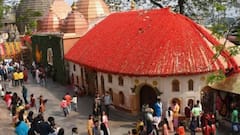'Moment Of Honour, Pride': CM Himanta On Assam Getting GI-Tag Certificate For Gamosa
Assam CM Himanta Biswa Sarma said that this GI label would be one more step for taking Assam and putting it on the world stage.

Assam Chief Minister Himanta Biswa Sarma on Thursday got the Geographical Indication Registration Certificate for Asomiya Gamosa. At a ceremony in Guwahati's Sarusajai Stadium, CM Biswa Sarma was presented with the certificate by Dr. Unnat P. Pandit, the Controller General of Patent, Designs, and Trademarks and Registrar of the GI Registry.
Eight Gamosa have been included in GI Registration, including Uka or Xadharan Gamosa, Phulam Gamosa, Bihuwan, Tiani or Pani Gamosa, Anakata Gamosa, Telos Gamosa, Dora Boron or Jor Gamosa, and Gossain Gamosa.
The legal recognition of goods for a specific geographical area or territory is known as GI Registration, and no one else can produce or market the product.
Additionally, the GI Tag will guarantee the state's tens of thousands of weavers' safety.
"It is a moment of honour and pride for the people of Assam just before the Rongali Bihu celebrations as I received the GI Tag for our pride the Asomiya Gamosa," Chief Minister Sarma said at the event.
"As a result of this honour, our pride Asomiya Gamosa will receive legal recognition for Assam which will protect its quality and distinctiveness. It will ensure the protection of the interests of our weavers," he added.
The Gamosa is the quintessential symbol of Assam's heritage and a pride of our State.
— Himanta Biswa Sarma (@himantabiswa) April 13, 2023
Bohag Bihu got even more special for all 3.5 cr people of Assam, as on their behalf I formally received the Geographical Indication (GI) tag certificate for the Gamosa. (1/2) pic.twitter.com/GOrfo2Rhj9
The Assamese New Year is marked by Rongali, or Bohag Bihu, which is observed annually in the first week of the month Bohag (mid-April). The Assamese celebrate Bihu three times a year, Bhogali or Magh Bihu in January, Bohag or Rongali Bihu in April, and Kongali Bihu in October. These celebrations represent the various phases of farming.
The Assam CM at the event praised individuals of state on acquiring the honor. He said that this GI label would be one more step for taking Assam and putting it on the world stage.
What Is Gamosa?
The word Gamosa is derived from the Kamrupi word Gamsaw, the cloth used to cover the Bhagavad Purana at the altar. Literally translated, it means 'something to wipe the body with.
The Gamosa or Gamusa is an article of significance for the indigenous people of Assam.
It is generally a white rectangular piece of cloth with primarily a red border on three sides and red woven motifs on the fourth.
Although the cotton yarn is the most common material for making or weaving Gamosas, there are special occasion ones made from Pat silk.
A 1,455.3 meter-long Gamosa displayed in Delhi created a world record as it became the world's longest hand-woven piece of cloth.
The Gamusa has its origin from either the Tai people or from other people in East and Southeast Asia using similar articles.
Though it may be used daily to wipe the body after a bath, the use is not restricted to this.
It is also used to cover the altar at the prayer hall or cover the scriptures. An object of reverence is never placed on the bare ground, but always on a Gamosa.
It is used by the farmer, fishermen or hunter as a waistcloth or a loincloth. A Bihu dancer wraps it around the head with a fluffy knot.
Also Read: Assam's Bihu Makes A Mark On Global Stage With Guinness Record







































